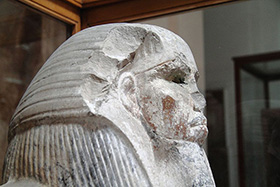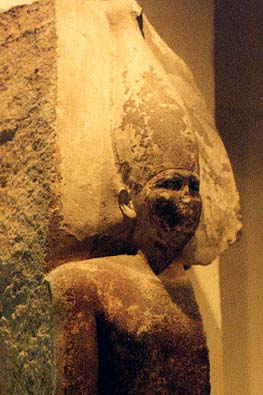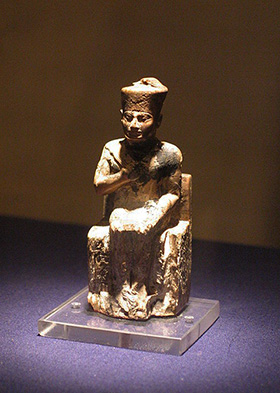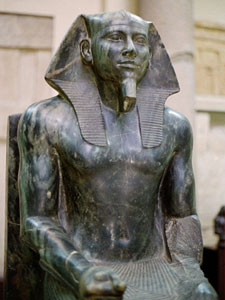

Menkaura
Kings associated with the Pyramids include Djoser (also known as Dzoser, Dzoser, Zoser, Tosorthos, and Dozer); Sneferu (also known as Snefru, Snofru, Soris); Kufu (also known as Kufu, Cheops, Kheops, Suphis I); Chepheren (also known as Khafre, Khafra, Rakhaef, Khephren, Suphis II).
The Old Kingdom began with the reign of Snefu. Djoser (2630-2611 B.C.) began the age of the Pyramids. Although he was really an Early Dynastic Period ruler he and his architect Imhotep built the first step pyramid and ushered in a period in which much art was created. The last three pharaohs of the 4th dynasty — Cheops, Chephren and Mycerinus — built the three Great Pyramids of Giza and codified the structure of Egyptian society. Little is known about them. No papyrus scrolls from their era remain. There is only one existing likeness of Pharaoh Khufu — builder of the largest pyramid — and it is a small ivory statue. Herodotus wrote 2,000 years after Khufu’s death that Khufu was an impious tyrant who closed all the temples in his country and compelled his subjects “without exception to labor as slaves for his own advantage.” There is no hard evidence to back up these assertions. See Pyramids. Sphinx and Step Pyramids
Huni was the last Egyptian King of the 3rd Dynasty. He built a pyramid at Miedum on the edge of the Faiyum. However, it is still in dispute whether the Pyramid of Miedum was started by Huni and later finished by the Pharaoh Snefru, or whether Snefru started the Pyramid of Miedum. Unique to the pyramid; however, is the first square ground plan. This was an architectural invention which lasted well into the future of Egyptian pyramids. [Source: Minnesota State University, Mankato, ethanholman.com +]
Sahure was the Second King of the 5th Dynasty. There is evidence of trade outside the Nile Valley during his reign and this might have been the beginning of trade with the outside worked or just a continuation of an already existing trade route. It was during Sahure's reign that expeditions were sent to the Near East for cedar trees which were important in later temple building. His pyramid was the largest and best preserved of the 5th Dynasty kings and his mortuary temple contained scenes of conquest and expeditions.

King Djoser (sometimes spelled Zoser), also known as Netjerikhet, ruled Egypt during the Third Dynasty of the Old Kingdom around 2650 BCE. Djoser was the first pharaoh to live only at Memphis rather than traveling between palaces. He also extended Egypt’s power all the way south to Aswan, and north to Sinai.
Djoser is well known for two reasons: First, he is credited with saving Egypt from a seven year famine by re-building the Temple of Khnum, the god of the Nile River’s source. Second, and more importantly, Djoser is known for his funerary monument, the Step Pyramid at Saqqara, which was notably built out of stone blocks rather than mud bricks under the guidance of the famed architect Imhotep. The fact that Djoser was able to end a famine and build such a large monument suggests that during his reign, Egypt was politically and economically stable.
Image: Djoser statue at the Egyptian Museum Cairo, Egypt.
Photo credit: By Djehouty - Own work, CC BY 3.0
https://www.britannica.com/biography/Djoser
Clayton, Peter A. Chronicle of the Pharaohs: The Reign-by-Reign Record of the Rulers and Dynasties of Ancient Egypt. London: Thames & Hudson, 2006.
Van De Mieroop, Marc. A History of Ancient Egypt. John Wiley & Sons, Ltd. Sussex. 2011.
Snefru (aka Sneferu) was the first pharaoh of the Fourth Dynasty, during the Old Kingdom Period. His name meant “to make beautiful”. After his death, the Egyptians remembered him as a good and just ruler. His reign provided the basic labor structure his successor, Khufu, used to build the Great Pyramid.

The relationship between the pharaohs of the Third and Fourth Dynasties is uncertain. The last king of the Third Dynasty, Huni, might have been Snefru's father, but there is no substantial evidence to prove this.
Snefru is known to have married Hetepheres, the daughter of Huni. If Snefru was also the son of Huni, this means that he married his half sister, like several other famous Egyptian pharaohs. This practice was meant to solidify the king's claim to the throne.
Snefru had several children beside his heir, Khufu. Some scholars think that Snefru's first vizier, Prince Nefermaat, was also his son.
Egyptologists found a mastaba (tomb) for one of Snefru's sons near his Meidum pyramid. Some think that the pharaoh might have moved his capital after his son's death. Other mastabas belonging to Snefru's various children were founds in different graveyards, enabling scholars to compile a list of Snefru's children.

Possibly the most famous Old Kingdom pharaoh, Khufu was the second pharaoh of the Fourth Dynasty. His full name is Khnum-Khufu, or “Protected by Khnum.” The Greeks called him Suphis or Cheops. Existing records show that he could have reigned anywhere from 23 to 34 years; Manetho, a third century BCE historian, even suggested a reign of 63 years. He is believed to have extended the borders of Egypt into the Sinai.
Khufu is also generally believed to be the builder of the Great Pyramid of Giza, which is the largest pyramid ever built and the first in the Giza complex.
Egypt prospered under the pharaohs of the Fourth Dynasty, which is why they were able to fund their massive building projects. Khufu was succeeded by his son Djedefre, whose reign was quite short, and then by Khafre, another of his sons. Khafre was the builder of the second Giza pyramid.
Image: Khufu statue at the Egyptian Museum Cairo, Egypt.
Photo credit: By Chipdawes - Own work, CC BY 3.0
http://www.ancientegyptonline.co.uk/Khufu.html
David, Anthony and Rosalie. A Biographical Dictionary of Ancient Egypt. London: Taylor & Francis, 1992.
Lehner, Mark and Richard H. Wilkinson. The Complete Pyramids: Solving the Ancient Mysteries. London: Thames & Hudson, 1997.

Khafre (or Khafra, “appearing like Re”) was the son of Khufu (probably by Queen Henutsen), and the brother of his predecessor Djedefre. His chief wives were Queen Khamaerernebty I (the mother of Menkaure, his successor) and Queen Meresankh III (daughter of his brother Crown Prince Kawab). He had a number of sons including: Menkaure, Nebemakhet, Misuerre, Khenterka, Duaenre, Nikawre (Nekure), and Sekhemkare. We also know of a couple of his daughters: Khameremebty II and Shepsestkau.
